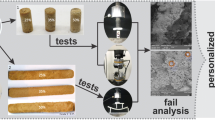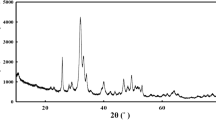We studied the features of hydrolytic degradation of polylactic acid (PLLA) implants depending on their structural filling with hydroxyapatite (HA). The resistance to in vitro hydrolysis was tested for the following samples: PLLA without HA (control; group 1), PLLA/HA 25 wt% (group 2), and PLLA/HA 50 wt% (group 3). Samples were incubated at 37°C. In the hydrolysate, lactate, calcium ions, and inorganic phosphate were determined. Additionally, the time of appearance of visual deformation and sample disintegration was recorded. PLLA degradation was higher in samples saturated with HA. The highest resistance to deformation was noted for samples without HA. Samples with a PLLA/HA 50 wt% demonstrated the maximum degradation of PLLA in combination with lower resistance to deformation and the highest bioavailability of calcium and phosphate. Group 2 samples are most promising for clinical use.
Similar content being viewed by others
References
Sheikh Z, Najeeb S, Khurshid Z, Verma V, Rashid H, Glogauer M. Biodegradable materials for bone repair and tissue engineering applications. Materials (Basel). 2015;8(9):5744-5794. https://doi.org/10.3390/ma8095273
Gilev MV, Zaytsev DV, Izmodenova MYu, Kiseleva DV, Volokitina EA. The influence of bone substitute material on mechanical properties of trabecular bone in augmentation of intra-articular impression fractures. experimental study. Genij Ortopedii. 2018;24(4):492-499. https://doi.org/10.18019/1028-4427-2018-24-4-492-499
Shuai C, Zan J, Yang Y, Peng S, Yang W, Qi F, Shen L, Tian Z. Surface modification enhances interfacial bonding in PLLA/MgO bone scaffold. Mater. Sci. Eng. C Mater. Biol. Appl. 2020;108:110486. https://doi.org/10.1016/j.msec.2019.110486
Son JS, Kim SG, Oh JS, Appleford M, Oh S, Ong JL, Lee KB. Hydroxyapatite/polylactide biphasic combination scaffold loaded with dexamethasone for bone regeneration. J. Biomed. Mater. Res. A. 2011;99(4):638-647. https://doi.org/10.1002/jbm.a.33223
Cushnie EK, Khan YM, Laurencin CT. Amorphous hydroxyapatite-sintered polymeric scaffolds for bone tissue regeneration: physical characterization studies. J. Biomed. Mater. Res. A. 2008;84(1):54-62. https://doi.org/10.1002/jbm.a.31380
Gandhi AD, Kaviyarasu K, Supraja N, Velmurugan R, Suriyakala G, Babujanarthanam R, Zang Y, Soontarapa K, Almaary KS, Elshikh MS, Chen TW. Annealing dependent synthesis of cyto-compatible nano-silver/calcium hydroxyapatite composite for antimicrobial activities. Arabian J. Chem. 2021;14(11):103404. https://doi.org/10.1016/j.arabjc.2021.103404
Popkov AV, Kulbakin DE, Popkov DA, Gorbach EN, Kononovich NA, Danilenko NV, Stankevich KS, Choynzonov EL, Zheravin АА, Khlusov IA, Bondar LN, Perelmuter VM, Bolbasov EN, Tverdokhlebov SI. Solution blow spinning of PLLA/hydroxyapatite composite scaffolds for bone tissue engineering. Biomed. Mater. 2021;16(5). https://doi.org/10.1088/1748-605X/ac11ca
Shive MS, Anderson JM. Biodegradation and biocompatibility of PLA and PLGA microspheres. Adv. Drug Deliv. Rev. 1997;28(1):5-24. https://doi.org/10.1016/s0169-409x(97)00048-3
Li X, Feng Q, Cui F. In vitro degradation of porous nano-hydroxyapatite/collagen/PLLA scaffold reinforced by chitin fibres. Mater. Sci. Engin. C. 2006;26(4):716-720. https://doi.org/10.1016/j.msec.2005.06.062
Lyyra I, Leino K, Hukka T, Hannula M, Kellomäki M, Massera J. Impact of glass composition on hydrolytic degradation of polylactide/bioactive glass composites. Materials (Basel). 2021;14(3):667. https://doi.org/10.3390/ma14030667
Author information
Authors and Affiliations
Corresponding author
Additional information
Translated from Byulleten’ Eksperimental’noi Biologii i Meditsiny, Vol. 174, No. 7, pp. 114-118, July, 2022
Rights and permissions
Springer Nature or its licensor (e.g. a society or other partner) holds exclusive rights to this article under a publishing agreement with the author(s) or other rightsholder(s); author self-archiving of the accepted manuscript version of this article is solely governed by the terms of such publishing agreement and applicable law.
About this article
Cite this article
Popkov, A.V., Stogov, M.V., Gorbach, E.N. et al. Hydrolysis of Bone-Replacing Materials Based on Polylactic Acid and Containing Hydroxyapatite in an In Vitro Experiment. Bull Exp Biol Med 174, 99–103 (2022). https://doi.org/10.1007/s10517-022-05656-3
Received:
Published:
Issue Date:
DOI: https://doi.org/10.1007/s10517-022-05656-3




